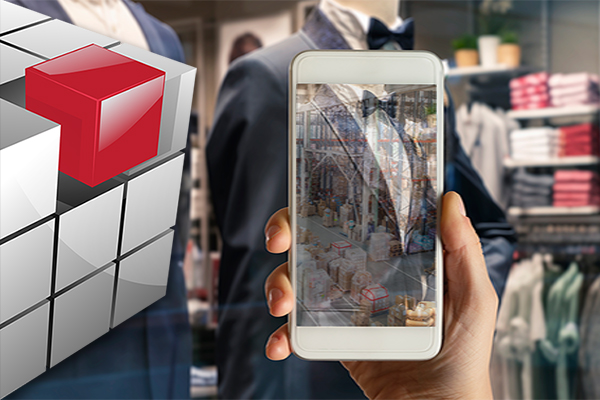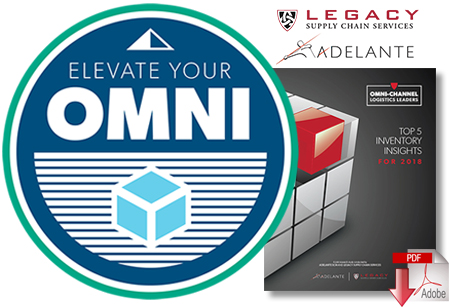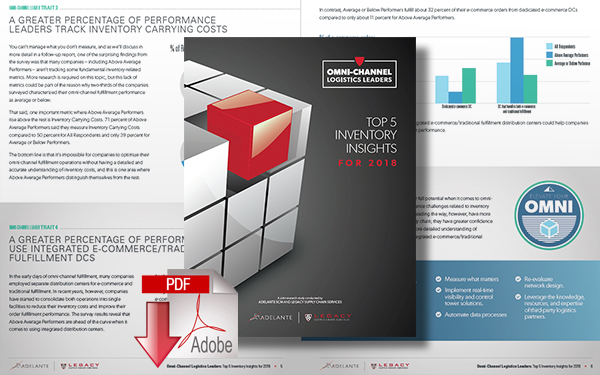9 Omni-Channel Logistics Challenges Facing Your Supply Chain

Omni-channel logistics is all about providing consumers with a seamless shopping experience and is only attainable when businesses leverage their ecommerce capabilities with running both a brick-and-mortar storefront and distribution center network.
Omni-Channel Logistics
Omni-channel logistics enables businesses to tailor how their products are purchased and delivered to meet the needs of the modern customer.
Consumers expect to find the products they want both in-store and online, to use technology to make purchases with the swipe of a finger and to have their purchase delivered to their doorstep the very next day.
The expectation of instant consumer gratification has businesses scrambling to shore up their supply chain to ensure cost-effective on-time delivery, which is where omni-channel logistics comes into play.
Download Omni-Channel Logistics Leaders: Top 5 Inventory Insights
Omni-channel logistics strategy seeks to synchronize inventory, logistics and distribution functions across all sales channels to meet consumer demand.
Retailers, manufacturers, distributors and wholesalers alike are developing complex omni-channel logistics solutions to ensure that their supply chain creates optimal levels of the all-important cost-to-serve metric.
For example, it makes more sense to ship a customer a product from their local retail store than from a distribution center hundreds of miles away.
There are many use cases for omni-channel logistics:
- Online order fulfilled directly to the buyer’s home
- Online order sent to a brick-and-mortar store for in-store pickup (a popular way to drive new traffic to brick-and-mortar storefronts)
- In-store purchase of an out-of-stock item delivered at a later date to the store or directly to the buyer’s home
- Online order submitted via eRetail channel (e.g. Amazon) and fulfilled directly to the buyer’s home via eRetailer’s or seller’s distribution infrastructure
- Order drop-shipped directly to consumer from a product manufacturer or CPG business via online retail storefront
- Online order and in-store purchase returns management
Omni-channel logistics enable supply chain professionals to synchronize inventory flow across all sales channels and comes with its own unique set of challenges.
If these challenges are overlooked, they can lead to lost sales and dilution of brand value.
The 9 Top Omni-channel Logistics Challenges Businesses Face
1. Lack of Inventory Visibility and Metrics
In the world of omni-channel logistics, it’s crucial that businesses know the status of their inventory and whether it’s at a distribution center or retail location. The last thing a company wants is to promise next-day delivery to its customers and not be able to follow through. Inventory can be particularly challenging to keep track of during the holiday shopping season. To address this challenge, businesses must develop an efficient order fulfillment process through the use of a fine-tuned Warehouse Management System (WMS).
Companies that do omni-channel the right way use inventory visibility as an accurate forecast of future demand and plan their supply chain activities accordingly. In fact, the companies that do omni-channel best are able to sell orders online without ever taking physical possession of the product. Ecommerce and order management systems are synced in such a way that online shopping cart orders trigger a PO directly with the vendor, and an outsourced or in-house party within the business’s supply chain carries out fulfillment.
When it comes to inventory management and visibility, the old adage of “you can’t manage what you don’t measure” holds true. It’s important to track fundamental-inventory-related metrics such as Inventory Carrying Costs, Perfect Order % and % of Orders Filled from Ideal Inventory Location.
For metrics to matter, they must align with the customer, financial, and strategic objectives. And, in today’s multi-channel supply chain, metrics must indicate how efficiently and cost-effectively product flows through distribution networks to diverse retail locations, distributors and wholesalers, and end consumers.
2. Poor Visibility into Inventory in Transit
Both major enterprises and startups alike generally have relatively poor visibility into inventory in transit, which has led to an increasing demand for real-time freight visibility solutions. Leading omni-channel logistics solutions not only enable visibility into shipments and trucks but into orders and stock-keeping units, as well. These solutions also incorporate optimization capabilities and collaboration capabilities that facilitate communication and the exchange of data and information between trading partners. Leading solutions have started to embed machine learning capabilities and leverage a broader set of data sources - including weather, traffic, location, and social networking - to enable predictive capabilities and determine more accurate Estimated Times of Arrival.
Read: Increase Inventory Visibility across Your Supply Chain and Optimize Omni-Channel Fulfillment
3. Segmented Supply Chain Processes
If a business’s various supply chain processes don’t work together, it can’t ensure across-the-board customer satisfaction. Larger companies generally have many private warehouses and distribution centers, managed by different in-house and outsourced operators, that run on different systems. As a result, they employ different tactics to ensure their supply chain runs smoothly. The key to solving this supply chain segmentation is to consolidate these processes, rather than let them function in silos.
4. Unreliable Order Fulfillment Processes
When a business tells its customers that they will receive same-day or next-day delivery, it needs to deliver on that promise. An unreliable order fulfillment process can lead to shipping delays, which can deter customers from doing business with that company in the future. A good way to ensure a streamlined order fulfillment process is to use the proper technology to help forecast future delays in service or shipping.
5. Finding the Right Transportation
There are many different ways to get a product from a brick-and-mortar storefront or distribution center to the customer’s doorstep. The challenge is to find the most effective and efficient transportation solution to keep customers happy without driving up the landed product costs. Selecting the right shipping method for the right customer situation is essential to omni-channel logistics.
6. Reverse Logistics
The return process for any product should be just as seamless as its initial delivery. In this new omni-channel landscape, customers expect to be able to return products they’ve purchased online in store or by mail. Companies that don’t offer this ease of return are unlikely to generate repeat business. Implementing sound reverse logistics infrastructure is imperative for good customer service within the omni-channel logistics framework.
7. Manual Processes
One of the leading causes of inventory inaccuracy across supply chain nodes is the continued use of manual - often paper-based - processes to capture inventory data. Implementing a WMS with radio frequency (RF) and barcode scanning capabilities is a simple, yet important first step. The most advanced businesses have taken additional steps to automate inventory counts, such as using drones and RFID tags. This automation makes it possible for them to compare results, identify discrepancies and create a more accurate picture of their inventory.
8. Overlooking Physical Transformation
Although digital transformation has received the lion’s share of attention from analysts and technology companies alike, businesses must take care not to lose sight of physical transformation. The method of flowing truckloads of products from large distribution centers to stores has become outdated. Businesses must update their supply chain and distribution networks to compete in this new market, in which speed of delivery and inventory reduction are paramount. Leading enterprises are testing out new distribution strategies in an attempt to become more agile and to better align with customer expectations for faster deliveries.
9. Implementing 3PL Strategy
A successful 3PL is an operations manager, a strategic consultant and an IT provider all in one. This combination of capabilities is especially valuable when it comes to inventory optimization and omni-channel fulfillment. A 3PL’s core competency in fulfillment operations - such as knowing which metrics to use and how to measure them to drive continuous improvement - can help companies both large and small close the capability gap.
What Consumers Want
Omni-channel logistics is all about providing consumers with a seamless shopping experience.
This experience is only attainable when businesses leverage their e-commerce capabilities in a way that acknowledges the reality of running both a brick-and-mortar storefront and distribution center network.
The right 3PL partner can use its retail and shipping industry knowledge and supply chain experience, as well as a diverse set of WMS capabilities and integration strategies to address the challenges listed above.
Read: Industry Study looks at Inventory Management as a Critical Function within Omni-Channel Logistics
Download the Research Study
Omni-Channel Logistics Leaders: Top 5 Inventory Insights
Based on data collected from nearly 100 companies actively engaged in retail, manufacturing and logistics services, this research paper has provided several valuable insights ranging from current challenges & best practices, characteristics of companies considered high performers, and opportunities for improvement from companies lower on the omni-channel performance curve. Download Now!
Article Topics
LEGACY Supply Chain Services News & Resources
Outsourcing eCommerce Fulfillment to a 3PL Rapidly Improve the Performance of Your Warehouse Logistics 20 Warehouse & Distribution Center Best Practices for Your Supply Chain Warehouse Contingency Planning Template 7 Last Mile Logistics Delivery & Ecommerce Trends You Don’t Want to Overlook Increase Inventory Visibility across Your Supply Chain and Optimize Omni-Channel Fulfillment Omni-Channel Logistics Leaders: Top 5 Inventory Insights More LEGACY Supply Chain ServicesLatest in Supply Chain
Walmart Unleashes Autonomous Lift Trucks at Four High-Tech DCs Ranking the Best Countries for Private Business in EMEA Frictionless Videocast: The Importance of Water at the U.S./Mexico Border with Commissioner Maria-Elena Giner, International Boundary and Water Commission Why are Diesel Prices Climbing Back Over $4 a Gallon? Plastic Pollution is a Problem Many Companies are Still Ignoring Luxury Car Brands in Limbo After Chinese Company Violates Labor Laws 80% of Companies Still Unsure How to Best Leverage AI, Study Finds More Supply Chain
















